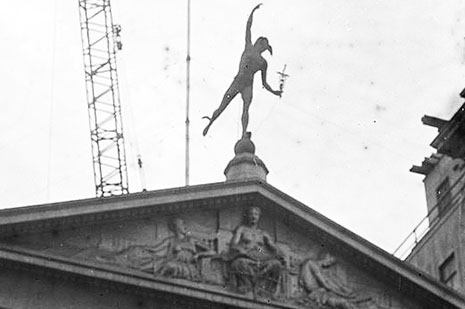THE sun is setting on the world of journalism in which I have worked for more than fifty years. Radical changes announced by Fairfax and News Ltd, combined with Gina Rinehart’s push for control of Fairfax, seem certain to reshape Australian journalism.
The industry will employ fewer people; newspapers will shrink in size and possibly be replaced altogether by electronic devices like tablets; a new proprietor will want to influence the Fairfax newspaper policy. Naturally there has been much breast-beating over the future of “quality journalism” and concern over the possibility that Rinehart will “trash the Fairfax brand” by using the newspapers to promote her mining interests.
Certainly there are things to worry about. Will bright young potential journalists of the future be attracted to an industry that is contracting, strapped for cash and offering a future of low pay and limited prospects? Can quality journalism be delivered by substantially fewer and probably less talented and less motivated employees? Will the new Fairfax proprietor trash the brand by turning the newspapers into mining industry gazettes?
There is also cause for concern over contemporary newspaper obsessions with sex, sport and sin at the expense of serious analysis. Oddly, as newspapers become more trivial, they seem to see themselves increasingly as self-righteous arbiters of public taste and opinion, and journalists, especially senior journalists, seem increasingly pompous and opinionated. They would do well to remember that journalism is ultimately a humble, if often privileged, occupation.
Old journalists are notoriously sentimental and self-indulgent and much given to reminiscing about the good old days (and their own achievements). They tend to think that they had the best of a golden age when great editors and tolerant proprietors, enriched by “rivers of gold” classified advertising revenue, presided benignly over earnest journalists working to produce influential journalism that spoke truth to power and struck fear into the hearts of political, commercial and criminal shysters everywhere. That is nonsense.
Certainly newspapers used to be richer; money was almost a free good and journalists had greater opportunities to pursue their interests and the issues of the day. Certainly newspapers attracted and held bright people with a sense of vocation and democratic duty (as well as a goodly number of fools and ratbags). But in my experience there was no golden age, no Arcadian past of smooth, seamless quality journalism. Life on newspapers was never smooth and stable. It was always in flux and being affected by the impact of the economic cycle on the “rivers of gold” revenue. And proprietors were always using newspapers to promote their political and commercial interests. They were wilful, arrogant, conservative, sometimes paranoid, but they were not fools. They knew that “trashing the brand” would be self-defeating. They had to seem to permit a range of views in their publications.
If I am right, editors and journalists have always been embroiled in a sort of arm-wrestle with the owners and money managers of media companies, and they have always had to live with proprietors with, at best, limited regard for the notion of journalistic independence and integrity. In times of plenty, journalistic life was largely unconstrained by pressure from money men and proprietors, but the financial screws were inevitably tightened when times got tougher. After all, profits (“shareholder value”) ultimately matter more to media proprietors and board members than the pursuit of truth. The main difference these days is that the impact of the internet has forced the big companies to pursue new and more urgent strategies for survival.
LET me illustrate this argument with some personal and corporate history. I walked into the offices of the Melbourne Age, then at the corner of Collins and Swanston Streets, in January 1960 to start my life in journalism. It was a Dickensian place, full of Dickensian characters, many of whom smoked and drank too much. I worked for the paper for the best part of forty years, becoming a leader writer, news editor, assistant editor, and European and Washington correspondent. It was never a stable, settled place; it rose and it declined in line with how proprietors, boards, editors and journalists judged events in the world and their relations with each other. Some were good; some were awful. But the place soldiered on. The only Golden Age was the pub around the corner from the new premises built for the Age opposite Spencer Street railway station.
The Dickensian age of the Age was ending when I walked into the old Collins Street building crowned with a statue of Mercury, the winged messenger of the Gods. It was still a grubby and gloomy old warren, crowded with grubby and gloomy old people who had done things their way for years. But there was also a cohort of lively roistering reporters, led by John Sorrell and Chris Forsyth; and Graham Perkin, who was to become the great mid-twentieth-century editor of the paper, was already the assistant news editor and straining under the decent but dreary editorship of Keith Sinclair.
Plans were soon afoot to remodel and renovate the place. The old and cramped reporters’ and sub-editors’ rooms with their wooden benches and trestles would be made over into modern office spaces. Young Ranald Macdonald, a scion of the Syme family, had returned from Cambridge and was soon moving to replace his stepfather, the reactionary buffoon E.H.B. Neill, as chief executive. And lower on the totem pole, under Perkin, new generations of journalists were emerging and displacing the older time-servers – people like Greg Taylor, Claude Forell, Neil Jillett, Creighton Burns and Les Tanner, and my generation, which included Les Carlyon, Michelle Grattan, John Hamilton, Peter Cole-Adams, Ben Hills, and others. These new generations emerged when Macdonald replaced Sinclair with Perkin in 1966 and when Perkin – with the backing of Macdonald, one of the more enlightened newspaper proprietors of his time – set about transforming the whole paper. You can read a splendid account of these times in Ben Hills’s biography of Graham Perkin, Breaking News (Scribe, 2010).
It is tempting for those of my ilk to look back on the Macdonald–Perkin years as the Golden Age. The Age was dramatically transformed. Apart from the new talent he injected into the place, Perkin took on new issues and adopted new policies, starting by reversing Sinclair’s opposition to water fluoridation. The paper won national and international respect, and it occupied the huge brick veneer plant built on the corner of Spencer and La Trobe streets with aggressive confidence.
But the point is that nothing endured for long. After the sudden and untimely death of Perkin in 1975 there was a succession of editors: Les Carlyon, Greg Taylor, Michael Davie, Creighton Burns, Mike Smith and others. Technology was changing too: the old hot-metal typesetting gave way to computer setting long before the internet, portable computers and mobile phones appeared on the horizon. And whenever the economic cycle turned down, even momentarily, there were cost-cutting campaigns, calls for job cuts, and grim predictions about the future of the newspaper. There is little new under the sun in the newspaper business.
Notwithstanding hand-on-heart pledges of editorial independence, proprietorial influence was always an issue. Perkin was able to get away with plenty because of the Age’s commercial success, but he had a keen sense of the limits of his independence. As Ben Hills points out, the paper advocated a vote for Labor in only one of the seven state and federal elections held while Perkin was editor. And his support for Labor in the 1972 federal election had to be limited and grudging, although he won a battle with the board and E.H.B. Neill on the issue. Neill, for his part, would later compromise the independence of the Age by allowing Fairfax to gain control of the company.
SO there is nothing new in proprietorial interventions. David Syme (1827–1908), founder of the Age with his brother Ebenezer, had no qualms about using the newspaper to advocate the protectionist cause ahead of the conventions to draw up the Australian constitution. In 1897 the ten Victorians elected as convention delegates were the ten on the Age’s protectionist ticket organised by Syme. The reputation of the newspaper survived intact.
Sixty-four years later, Warwick Fairfax turned against prime minister Robert Menzies and backed Labor’s Arthur Calwell in the 1961 federal election. Menzies won narrowly (by two seats) but was returned with a strong majority two years later when he called an early election at which, this time, he was backed by Fairfax. So proprietors have always done what they have wanted to do with their newspapers. They support individuals and causes they judge to be favourable to their interests; they use their newspapers to cross-promote their political, sporting and business interests; they settle scores, conduct feuds, pursue enemies and pamper friends. They highlight views that they support and play down those that they oppose.
So what? They understand the commercial value of credibility and the commercial curse of being seen as overwhelmingly and aggressively on one side of social and political issues (although you have to wonder about the Australian on some days). Newspaper proprietors understand it is in their interest to reflect a range of views, to permit and encourage public debate, within quite limited boundaries. But they are conservative men and women and they ensure that editors and managers appointed to run their businesses understand and support their views. It would be surprising if they didn’t.
Much is made of the Fairfax charter of editorial independence. But it is essentially a document of convenience and self-interest. It is not holy writ. It certainly serves the valuable but limited purpose of reminding proprietors and editors – and readers – of their responsibilities to the idea of free and independent journalism. But in fact everybody understands the limits despite the often misty boundaries. Serious clashes are rare. Few editors are willing to die in a ditch and lose well-paying jobs for an editorial principle – unless it is of fundamental importance. And there are few such principles that cannot be negotiated between editors and boards.
Gina Rinehart could safely sign the Fairfax charter knowing that there is little chance of any Fairfax editor campaigning against the mining industry and supporting the minerals tax. Her industry is of national importance and it is not in the nature of newspapers to support new taxes or tax increases that penalise businesses of this significance. Fair (but subordinated) alternative views can be accommodated without risk in Fairfax newspapers.
So I remain reasonably sanguine about the future of journalism. It may be produced by fewer people and increasingly delivered in tabloids or on tablets. It has to find adequate resources to fund good work and to attract good people. But the survival imperative should keep the industry in a healthy if somewhat straitened condition. Sadly there seems no shortage of resources to report the glib, the glossy and the gossipy, the celebrity stalkers, the tattooed apes of the sports arenas, and the gurus of food, fashion and foolishness. It is this descent into populist fatuity that may constitute a bigger threat to journalism than the internet and Gina Rinehart. •




